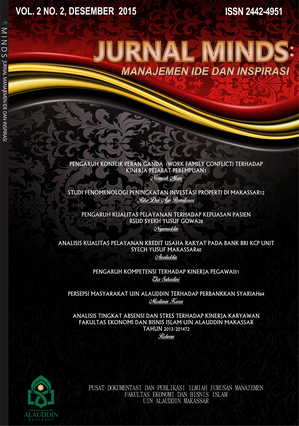Date Log
Copyright (c) 2021 Ni Made Rastini, Ni Nyoman Rsi Respati

This work is licensed under a Creative Commons Attribution 4.0 International License.
Public Attitudes and Interests in Using Online Transactions (TAM Application And TRA Model)
Corresponding Author(s) : Ni Made Rastini
Jurnal Minds: Manajemen Ide dan Inspirasi,
Vol. 8 No. 1 (2021): June
Abstract
This study aims to investigate the public's interest in using online transactions, especially mobile by Technology Acceptance Model (TAM) and Theory of Reasoned Action (TRA). The sample in this study was 200 people. The data analysis technique in this study used Partial Least Square (PLS). The results showed that the perceived ease of use and perceived usefulness had a positive and significant effect on user attitudes. Subjective norm variables, user attitudes have a positive and significant impact on individual behavior interest, perceived ease of use has a positive and significant effect on the perceived usefulness. This research suggests that the banking sector is expected to add features to make it easier and provide more benefits for their customers in using mobile banking.
Keywords
Download Citation
Endnote/Zotero/Mendeley (RIS)BibTeX
References
Aboelmaged, M., & Gebba, T. R. (2013). Mobile Banking Adoption: An Examination of Technology Acceptance Model and Theory of Planned Behavior. International Journal of Business Research and Development, 2(1), 35‐50.
Adhiputra, W. (2015). Aplikasi Technology Acceptance Model Terhadap Layanan Internet Banking. Kalbisocio, 2(1), 52-63.
Ajzen, I., & Fishbein, M. (1980). Understanding attitudes and predicting social behaviour. Englewood Cliffs, 5(4), 315–330.
Anandarajan, M., Igbaria, M., & Anakwe, U.P. (2000). Technology acceptance in the banking industry: A perspective from a less developed country. Information Technology & People, 13(4), 298-312
Arthana, Yudhi W, Rukhviyanti, N. (2015). Pengaruh Minat Individu terhadap Penggunaan Mobile Banking (M-Banking): Model Kombinasi Technology Acceptance Model (TAM) dan Theory of Planned Behavior(TPB). Jurnal Informasi, VII(1), 25–44.
Bashir, I., & Madhavaiah, C. (2015). Consumer attitude and behavioural intention towards Internet banking adoption in India. Journal of Indian Business Research, 7(1), 67-102.
Bahiyah, N., dan Kusumadewi, S. (2013). Pengaruh Perceived Usefulness dan Percieved Ease of Use terhadap Perilaku Pemanfaatan Magnetic Resonance Imaging (MRI) oleh Tenaga Medis. Seminar Nasional Informatika Medis (SNIMed) IV. Magister Teknik Informatika. Fakultas Teknologi Industri. Universitas Islam. http://fit.uii.ac.id/files/snimed/20 13/008.pdf.
Chen, C. C., & Tsai, J. L. (2019). Determinants of behavioral intention to use the Personalized Location-based Mobile Tourism Application: An empirical study by integrating TAM with ISSM. Future Generation Computer Systems, 96, 628–638.
Davis, F. D. (1989). Perceived usefulness, perceived ease of use, and user acceptance of information technology. MIS Quarterly: Management Information Systems, 13(3), 319–339 .
Juwaheer, T. D., Pudaruth. S., & Ramdin, P. (2012). Factors Influencing The Adoption Of Internet Banking: A Case Study Of Commercial Banks In Mauritius. World Journal Of Science, Technology And Sustainable Development, 9(3), 204-234.
Handayani, R. (2007). Analisis Faktor – Faktor yang Mempengaruhi Minat Pemanfaatan Sistem Informasi dan Penggunaan Sistem Informasi (Studi Empiris pada Perusahaan Manufaktur di Bursa Efek Jakarta). Semarang : Tesis Magister Sains Akuntansi Universitas Diponegoro.
Hill, R. J., Fishbein, M., & Ajzen, I. (1977). Belief, Attitude, Intention and Behavior: An Introduction to Theory and Research. Contemporary Sociology, 6(2), 244-245
Kurniawan, D., Semuel, H., & Japarianto, E. (2013). Analisis Penerimaan Nasabah terhadap Layanan Mobile Banking dengan Menggunakan Pendekatan Technology Acceptance Model dan Theory of Reasoned Action. Jurnal Manajemen Pemasaran, 1(1), 1–13.
Laily, N., & Riadani, F. S. (2019). The Factors Influencing Perceived Ease of Use of E-Learning by Accounting Lecturer. Journal of Accounting and Business Education, 3(2), 142-150.
Leng, G.S., Lada, S., Muhammad, M.Z., Ibrahim, A. & Amboala, T., (2011). An exploration of social networking sites (SNS) adopton in Malaysia using Technology Acceptance Model (TAM), Theory of Planned Behavior (TPB) and Intrinsic Motvaton. Journal of Internet Banking and Commerce, 16(2), 1–27
Mas’ud, M. H. (2012). Pengaruh Sikap, Norma-Norma Subyektif dan Kontrol Perilaku Yang Dipersepsikan Nasabah Bank Terhadap Keinginan Untuk Menggunakan Automatic Teller Machine (ATM) Bank BCA di Kota Malang. Jurnal Manajemen dan Akuntansi, 1(3), 13-28.
Mayasari, F. , Kurniawati, E., P., Dan Nugroho, P., I. (2011). Anteseden Dan Konsekuen Sikap Nasabah Dalam Menggunakan Internet Banking Dengan Menggunakan Kerangka Technology Acceptance Model (Tam) (Survey Pada Pengguna Klikbca). Sematik, 11(01).
Mohammadi, H. (2015). Factors affecting the e-learning outcomes: An integration of TAM and IS success model. Telematics and Informatics, 32(4), 701–719.
Nasri, W., & Charfeddine, L. (2012). Factors affecting the adoption of Internet banking in Tunisia: An integration theory of acceptance model and theory of planned behavior. Journal of High Technology Management Research, 23(1), 1–14.
Oktapiani, R. (2017). Interpretasi Model Penerimaan Sistem Ujian Online Dengan Pendekatan Technologi Acceptance Model (TAM) Dan Theory Planned Of Behavior (TPB) Di Smk Pasim Plus Kota Sukabumi. Swabumi, 5(1), 98-107.
Peterson, D. K. (2012). The Colbert Bump And The Facebook Follow-Through For Generation Snark: A Test And Extension Of The Ajzen’s Theory Of Planned Behavior For 2012. Journal Of Management Research, 4(3), 43–65.
Putri, N., & Suprapti, N. (2016). Aplikasi Model Tam Dalam Menjelaskan Niat Menggunakan Mobile Commerce Di Kota Denpasar. E-Jurnal Manajemen Universitas Udayana, 5(4), 2341-2368.
Ratnaningrum, R. A.. (2013). Aplikasi Model Tam Terhadap Pengguna Layanan Internet Banking Di Kota Denpasar.Tesis Program Magister Program Studi Manajemen Pascasarjana Univeristas Udayana.
Saputra, E. (2013). Analisis Penerimaan Sistem Informasi Manajemen Rumah Sakit Umum Daerah Bangkinang menggunakan Metode Technology Acceptance Model (TAM). Sitekin, 10(02). DOI: http://dx.doi.org/10.24014/sitekin.v10i2.539
Shroff, R. H., Dennen, C. C., & M.W.Ng, E. (2011). Analysis Of The Technology Acceptance Model In Examining Student’s Behavioural Intention To Use An E-Portofolio System. Australasian Journal Of Educational Technology, 27(4), 600-618
Solimun. (2010). Analisis Multivariant Pemodelan Structural Model Partial Least Square – PLS.Malang: CV. Citra.
Taylor, S. & Todd, P. A. (1995). Understanding Information Technology Usage: A Test of Competing Models. Information Systems Research, 6(2): 144-176.
Tirtana, I., & Sari, P. S. (2014). Analisis Pengaruh Persepsi Kebermanfaatan, Persepsi Kemudahan dan Kepercayaan terhadap Penggunaan Mobile Banking. Seminar Nasional Dan The 1st Call for Paper, 25, 671–688.
Yoga, P. (2012). 85 persen Transaksi Lewat E-Channel, Bank Mandiri Klaim Makin Efisien. Available at Http://Www.Infobanknews.Com/2012/07/85-Transaksi-Lewat-E-Channel-Bank-Mandiri-Klaim-Makin-Efisien/
https://www.republika.co.id/berita/qmednd463/penggunaan-qris-bali-naik-580-persen
